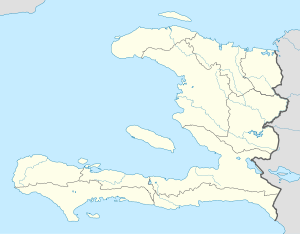Gonaïves
| Gonaïves Gonayiv | |
|---|---|
| Commune | |
|
| |
|
Nickname(s): La Cité de l'Indépendance The City of Independence | |
 Gonaïves Location in Artibonite, Haiti | |
| Coordinates: 19°27′N 72°41′W / 19.450°N 72.683°W | |
| Country |
|
| Department | Artibonite |
| Arrondissement | Gonaïves |
| Government | |
| • Mayor | Pierilus Sainjustin |
| Elevation | 6 m (20 ft) |
| Population (2011)[1] | |
| • Commune | 300,000 |
| • Metro | 104,825 |
| Time zone | Eastern (UTC-5) |
| • Summer (DST) | Eastern (UTC-4) |
Gonaïves (Haitian Creole: Gonayiv) is a commune in northern Haiti, and the capital of the Artibonite department of Haiti. It has a population of about 300,000 people (2011 census). The city of Gonaives was founded in 1422 by Indians who named it "Gonaibo" (to designate a locality of caciquat of the Maguana). It is also known as Haïti's "independence city". The Bay of Gonaïves is named after the town.
History
The Battle of Ravine-à-Couleuvres
In 1802 an important battle of the Haitian Revolution, the Battle of Ravine-à-Couleuvres was fought near Gonaïves.
Haitian independence
Gonaïves is also known as Haiti's City of Independence because it was there that Jean-Jacques Dessalines declared Haiti, the former Saint-Domingue, independent from France on January 1, 1804 by reading the Act of Independence, drafted by Boisrond Tonnerre, on the Place d'Armes of the town.
Marie-Claire Heureuse Félicité, the wife of Jean-Jacques Dessalines, died here in August 1858.
Recent history
In the early 2000s, Gonaïves was the scene of substantial rioting and violence primarily motivated by opposition to President Jean-Bertrand Aristide, and on February 5, 2004, a group calling itself the Revolutionary Artibonite Resistance Front seized control of the city, starting the 2004 Haïtian rebellion. But in recent years the city has seen a complete return to calmness.
In September 2004, Hurricane Jeanne caused major flooding and mudslides in the city.
Four years later, the city was again devastated by another storm, Hurricane Hanna, which killed 529 people, mostly in flooded sections of Gonaïves, where the destruction was described as "catastrophic" and 495 bodies were discovered as late as September 5.[2][3] Haitian authorities said the tally would grow once officials were able to make their way through the city. "The assessment was only partial, because it was impossible to enter the city at that moment". Gonaïves Mayor Stephen Moise said at least 48,000 people from the Gonaïves area were forced into shelters.[4][5]
Media
- Radio Redemption 100.9 FM
- Radio Xplosion 96.5 FM
- Tele Radio new star fm 99.9 Chaine 13[6]
- Radio Continentale 99.5 FM
- Radio Sun 91.3 FM
- Radio Independence 101.5 FM stations affiliées: radio Metropole 100.1,[7] Lavwadlamerik[8]
- Radio Mega Max 95.9 FM
- Radio Kiss FM 96.9[9]
- Radio Provinciale 95.3 FM
- Radio Pyramide FM
- Radio Trans-Artibonite
- Radio Gonaïves 97.7 FM
- Radio Trans Atlantique 102.5 FM
- Radio Etincelle
- Radio Nouvelle Vision Chrétienne
- Radio Intrepide 97.3 FM[10]
- Radio Tambou FM
- Radio Express FM
- Radio Classic Inter FM
- Radio 4VEG FM
- Radio Espace FM
- Radio KL 2000 FM
- Radio Super Vision FM
- Radio Megamax FM
- Radio Main Dans La Main FM
- Radio Clarté 103.9 FM
- Radio Vision 2000 98.1 FM
- Radio Télé 2004 (101.1FM)
See also
References
- ↑ Institut Haïtien de Statistique et d'Informatique (IHSI)
- ↑ "Hurricane Ike targets Gulf as Hanna hits Carolinas". Reuters. 2008-09-06. Archived from the original on 2009-09-19.
- ↑ "Haiti Impact". Hurricane Hanna Info. 2008. Retrieved 2008-09-04.
- ↑ Charles, Jacqueline (2008). "Horrible scene in Haiti after Hanna". Miami Herald. Retrieved 2008-09-05.
- ↑ "Haiti - Politic : Michel Martelly in Gonaïves this Sunday". HaitiLibre. 2011-05-22. Retrieved 2013-12-19.
- ↑ "Radio New Star FM". Archived from the original on February 6, 2006.
- ↑ "Radio Metropole Haiti". Retrieved 2013-10-25.
- ↑ "VOA Nouvèl". Voice of America. Retrieved 2013-10-25.
- ↑ "Radio Kiss FM". Archived from the original on 2011-09-03.
- ↑ "Radio Intrépide FM".
External links and further reading
| Wikimedia Commons has media related to Gonaïves. |
- Latortue, Paul R., "Gonaives: the last 50 years" Caribbean Studies, Vol. 34, Núm. 1, enero-junio, 2006, pp. 263–274 University of Puerto Rico, Puerto Rico
Coordinates: 19°27′N 72°41′W / 19.450°N 72.683°W
